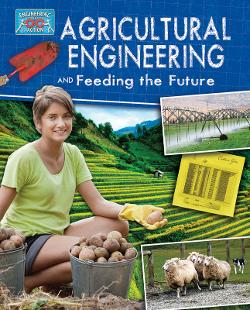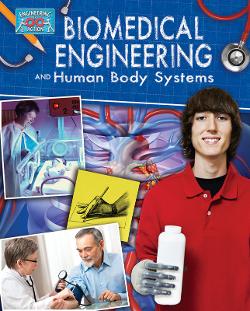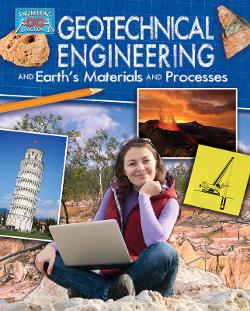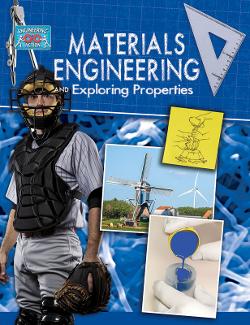| ________________
CM . . .
. Volume XXIII Number 19. . . .January 27, 2017
excerpt:
Four new titles have been added to Crabtree’s “Engineering in Action” series. Rebecca Sjonger is the author of Biomedical Engineering and Geotechnical Engineering, Robert Snedden has written Materials Engineering, and Anne Rooney is the author of Agricultural Engineering. Each book incorporates the design, layout, and organization of the first eight books in the series. This includes the use of simulated hand written post it notes, imitation field notes on sheets from a canary coloured legal pad, a background of blueprint paper used for drafting, and stock photographic images from a variety of sources. Each book begins with a title page, copyright page, and table of contents and ends with a “Learning More” page, glossary of terms identified by a bold font in the text (see examples in the excerpts above), and index. “Learning More” includes a list of six or seven books and four or five websites relevant to a particular book’s content, and identifies a place to visit in Biomedical Engineering (Biomedical Engineering Kiosk in Tampa, FL) and Materials Engineering (Museum of Science and Industry in Chicago, IL). The 26 pages of engineering information are focussed on explaining the eight steps in the design process for each specific engineering discipline (see the second excerpt above). There is also information on what agricultural, biomedical, geotechnical, and materials engineering involve, what an engineer from each discipline must know and be able to do, where and with whom engineers are likely to work, problems that have been solved, discoveries in the future that may eradicate today’s harms and impediments, and short vignettes of a selected few events or individuals important in each particular discipline. Sjonger and Rooney use a real problem as the context to help readers understand what agricultural, biomedical and geotechnical engineers identify as a human problem and to explain how these engineers attempt to rectify or overcome the identified problem using the design process that generally results in the creation of a new product. In Agricultural Engineering, farmers would like to mechanize the harvesting of ripe artichokes by humans who do this by cutting one artichoke at a time by hand. The goal is to create a machine that matches the speed of humans (6.25 artichokes per minute), identifies and cuts only ripe artichokes, and does so without damaging other artichokes. The problem in Biomedical Engineering is to build a prosthetic arm that functions like a real arm. That is, signals from the brain would direct the actions of the prosthesis, these signals had to be clear and constant, the prosthesis had to be comfortable to wear all day, safe for the user, able to work in normal environmental conditions (high and low air temperatures, when the user perspires and works around dirt), and manufactured at a reasonable cost. In Geotechnical Engineering, the problem facing the project engineers is to stop the flooding of Venice as the 100 islands upon which it is build slowly subside (sink) in response to moving tectonic plates and rising water levels, a consequence of climate change. All three are interesting and presented in ways that expose readers to the challenges faced and the work accomplished in each phase of the design process. Unlike Sjonger and Rooney, Snedden doesn’t follow the same problem through to its solution. He looks at the work involved at each step in the design process when designing the right material/materials for a particular job. This could be protective armour for soldiers that is lighter, a stronger coating for a helicopter that reduces friction, testing to determine why a material failed, or creating and testing a prototype of an ice skate that would better protect the feet of hockey players as engineering students at the University of Alberta have done. For readers who have had opportunities to carry out design projects in science or STEM (science, technology, engineering, mathematics) classes, these will be steps that are well-known. What isn’t likely as familiar is the bourgeoning and very exciting field of materials science and materials engineering where new composite materials, like bioplastics and magneto active elastomers, are developed and where nanotechnological methods are used to develop new materials by manipulating matter at molecular and atomic levels. All four books reviewed here include a “Design Challenge”. Whether or not they pose a challenge for Grades 5-8 students who have built, tested, modified, and re-tested prototypes since Kindergarten is questionable. Strengthening a cylinder made from card stock, building the foundation of a structure that will withstand an earthquake, making a simple “tool “for the outer ear that will improve hearing by collecting more sound waves, and developing a watering system for germinating seeds are common design process activities in Grades 1-4 when studying the strength and stability of structures, the sense of hearing, and the life cycle of plants. Given the age of reader for which the books were written and the often amazing products described by Sjonger, Snedden, and Rooney, it would have been wise to include design challenges that were original and involved more skill, ingenuity, and invention. Recommended. Barbara McMillan is a teacher educator and a professor of science education in the Faculty of Education, the University of Manitoba.
To comment
on this title or this review, send mail to cm@umanitoba.ca.
Copyright © the Manitoba Library Association. Reproduction for personal
use is permitted only if this copyright notice is maintained. Any
other reproduction is prohibited without permission.
Next Review | Table of Contents For This Issue - January 27, 2017 |



